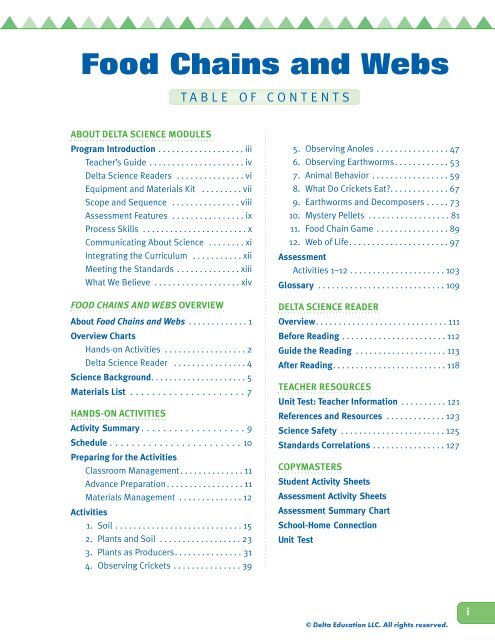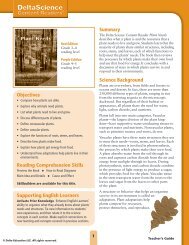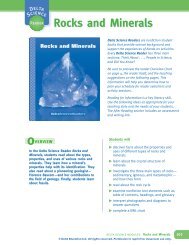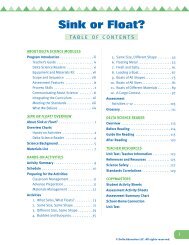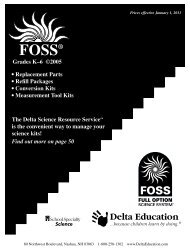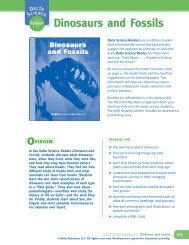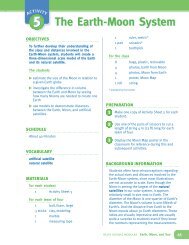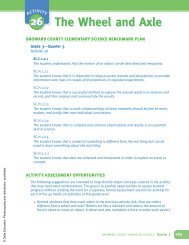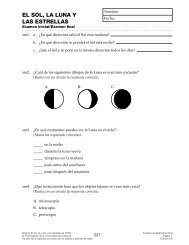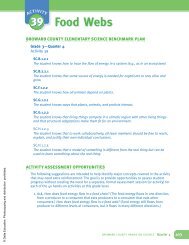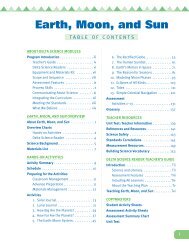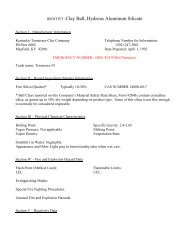Food Chains and Webs - Delta Education
Food Chains and Webs - Delta Education
Food Chains and Webs - Delta Education
You also want an ePaper? Increase the reach of your titles
YUMPU automatically turns print PDFs into web optimized ePapers that Google loves.
<strong>Food</strong> <strong>Chains</strong> <strong>and</strong> <strong>Webs</strong><br />
T ABLE OF<br />
CONTENTS<br />
ABOUT DELTA SCIENCE MODULES<br />
Program Introduction . . . . . . . . . . . . . . . . . . . iii<br />
Teacher’s Guide . . . . . . . . . . . . . . . . . . . . . iv<br />
<strong>Delta</strong> Science Readers . . . . . . . . . . . . . . . vi<br />
Equipment <strong>and</strong> Materials Kit . . . . . . . . . vii<br />
Scope <strong>and</strong> Sequence . . . . . . . . . . . . . . . viii<br />
Assessment Features . . . . . . . . . . . . . . . . ix<br />
Process Skills . . . . . . . . . . . . . . . . . . . . . . . x<br />
Communicating About Science . . . . . . . . xi<br />
Integrating the Curriculum . . . . . . . . . . . xii<br />
Meeting the St<strong>and</strong>ards . . . . . . . . . . . . . . xiii<br />
What We Believe . . . . . . . . . . . . . . . . . . . xiv<br />
FOOD CHAINS AND WEBS OVERVIEW<br />
About <strong>Food</strong> <strong>Chains</strong> <strong>and</strong> <strong>Webs</strong> . . . . . . . . . . . . . 1<br />
Overview Charts<br />
H<strong>and</strong>s-on Activities . . . . . . . . . . . . . . . . . . 2<br />
<strong>Delta</strong> Science Reader . . . . . . . . . . . . . . . . 4<br />
Science Background. . . . . . . . . . . . . . . . . . . . . 5<br />
Materials List . . . . . . . . . . . . . . . . . . . . . 7<br />
HANDS-ON ACTIVITIES<br />
Activity Summary . . . . . . . . . . . . . . . . . . . 9<br />
Schedule . . . . . . . . . . . . . . . . . . . . . . . . 10<br />
Preparing for the Activities<br />
Classroom Management . . . . . . . . . . . . . . 11<br />
Advance Preparation . . . . . . . . . . . . . . . . . 11<br />
Materials Management . . . . . . . . . . . . . . 12<br />
Activities<br />
1. Soil . . . . . . . . . . . . . . . . . . . . . . . . . . . . 15<br />
2. Plants <strong>and</strong> Soil . . . . . . . . . . . . . . . . . . 23<br />
3. Plants as Producers. . . . . . . . . . . . . . . 31<br />
4. Observing Crickets . . . . . . . . . . . . . . . 39<br />
5. Observing Anoles . . . . . . . . . . . . . . . . 47<br />
6. Observing Earthworms. . . . . . . . . . . . 53<br />
7. Animal Behavior . . . . . . . . . . . . . . . . . 59<br />
8. What Do Crickets Eat?. . . . . . . . . . . . . 67<br />
9. Earthworms <strong>and</strong> Decomposers . . . . . 73<br />
10. Mystery Pellets . . . . . . . . . . . . . . . . . . 81<br />
11. <strong>Food</strong> Chain Game . . . . . . . . . . . . . . . . 89<br />
12. Web of Life. . . . . . . . . . . . . . . . . . . . . . 97<br />
Assessment<br />
Activities 1–12 . . . . . . . . . . . . . . . . . . . . . 103<br />
Glossary . . . . . . . . . . . . . . . . . . . . . . . . . . . . 109<br />
DELTA SCIENCE READER<br />
Overview. . . . . . . . . . . . . . . . . . . . . . . . . . . . . 111<br />
Before Reading . . . . . . . . . . . . . . . . . . . . . . . 112<br />
Guide the Reading . . . . . . . . . . . . . . . . . . . . 113<br />
After Reading. . . . . . . . . . . . . . . . . . . . . . . . . 118<br />
TEACHER RESOURCES<br />
Unit Test: Teacher Information . . . . . . . . . . 121<br />
References <strong>and</strong> Resources . . . . . . . . . . . . . 123<br />
Science Safety . . . . . . . . . . . . . . . . . . . . . . . 125<br />
St<strong>and</strong>ards Correlations . . . . . . . . . . . . . . . . 127<br />
COPYMASTERS<br />
Student Activity Sheets<br />
Assessment Activity Sheets<br />
Assessment Summary Chart<br />
School-Home Connection<br />
Unit Test<br />
© <strong>Delta</strong> <strong>Education</strong> LLC. All rights reserved.<br />
i
About <strong>Food</strong> <strong>Chains</strong> <strong>and</strong> <strong>Webs</strong><br />
<strong>Delta</strong>ScienceModules, THIRD EDITION<br />
Students explore <strong>Food</strong> <strong>Chains</strong> <strong>and</strong> <strong>Webs</strong> through twelve<br />
h<strong>and</strong>s-on activities <strong>and</strong> the <strong>Delta</strong> Science Reader. Every bite<br />
we take connects us to a complex network known as a<br />
food web. Because most food webs begin with plants,<br />
students first explore plants as food producers. They<br />
experiment with soil <strong>and</strong> light to find the best growing<br />
conditions, <strong>and</strong> plant ryegrass in terrariums. Then they<br />
introduce crickets, earthworms, <strong>and</strong> anoles, <strong>and</strong> watch what<br />
happens. Students are soon able to classify each animal as<br />
a primary, secondary, or tertiary consumer, or decomposer,<br />
based on what it eats. For reinforcement, students role-play<br />
various predators <strong>and</strong> prey in a food chain game. By the<br />
end of the unit, students can apply their knowledge of<br />
specific plant <strong>and</strong> animal relationships to the underst<strong>and</strong>ing<br />
of food webs in nature.<br />
In the <strong>Delta</strong> Science Reader <strong>Food</strong> <strong>Chains</strong> <strong>and</strong> <strong>Webs</strong>,<br />
students read about what an ecosystem is, how living<br />
things in an ecosystem get energy, <strong>and</strong> how ecosystems<br />
can change. Students explore the interaction of living<br />
things <strong>and</strong> discuss food chains <strong>and</strong> webs. The book also<br />
presents biographical sketches of key scientists—Charles<br />
Darwin <strong>and</strong> Rachel Carson—<strong>and</strong> describes the work of an<br />
ecologist. Students also will discover the relationship<br />
between moose <strong>and</strong> wolf populations on Isle Royale <strong>and</strong><br />
consider the varied ecosystems on a mountain.<br />
<strong>Food</strong> <strong>Chains</strong> <strong>and</strong> <strong>Webs</strong> 1<br />
© <strong>Delta</strong> <strong>Education</strong> LLC. All rights reserved.
Overview Chart for H<strong>and</strong>s-on Activities<br />
1<br />
H<strong>and</strong>s-on Activity<br />
Soil<br />
page 15<br />
2 Plants <strong>and</strong> Soil<br />
page 23<br />
3<br />
Plants as Producers<br />
page 31<br />
4 Observing Crickets<br />
page 39<br />
5<br />
Observing Anoles<br />
page 47<br />
6 Observing<br />
Earthworms<br />
page 53<br />
Student Objectives<br />
• examine several soil samples <strong>and</strong> identify their components<br />
• test the samples for s<strong>and</strong>/silt/clay composition<br />
• prepare terrariums for study in later activities<br />
• discuss experimental design<br />
• plant seeds <strong>and</strong> measure plant growth<br />
• compare how plants grow in different soil mixtures<br />
• discuss the needs of plants<br />
• conduct an experiment to determine the effect of sunlight on plant growth<br />
• identify plants as producers<br />
• examine their crickets<br />
• identify the crickets’ body parts<br />
• record observations of cricket behavior<br />
• observe green anole features <strong>and</strong> behaviors<br />
• make records of their observations<br />
• discuss their observations with their classmates<br />
• measure the length of earthworms<br />
• draw <strong>and</strong> label the parts of an earthworm<br />
• observe earthworm features <strong>and</strong> behaviors<br />
7<br />
Animal Behavior<br />
page 59<br />
• continue to observe <strong>and</strong> record the behavior of the animals in their terrariums<br />
• draw conclusions about when anoles change color<br />
• observe anoles eating crickets <strong>and</strong> discuss anoles as secondary consumers<br />
8 What Do<br />
Crickets Eat?<br />
page 67<br />
9<br />
11<br />
Earthworms<br />
<strong>and</strong> Decomposers<br />
page 73<br />
10 Mystery Pellets<br />
page 81<br />
12<br />
<strong>Food</strong> Chain Game<br />
page 89<br />
Web of Life<br />
page 97<br />
Assessment<br />
page 103<br />
• observe how crickets respond to a variety of food choices<br />
• draw conclusions about the preferred food of crickets<br />
• place crickets in a food chain as primary consumers<br />
• locate <strong>and</strong> examine earthworm castings<br />
• infer what earthworms eat<br />
• discuss decomposition <strong>and</strong> decomposers<br />
• learn how earthworms fit into the food chain<br />
• offer ideas about the contents <strong>and</strong> origin of owl pellets<br />
• dissect pellets <strong>and</strong> identify bones found within<br />
• construct food chains that include owls<br />
• act out feeding relationships between crickets, anoles, <strong>and</strong> owls<br />
• discuss how it feels to be the prey or the predator<br />
• compare simulated food chain relationships with real ones<br />
• create diagrams of food webs on paper<br />
• compare food chains to food webs<br />
• infer why real food webs are so complex<br />
• See page 103.<br />
2 delta science modules<br />
© <strong>Delta</strong> <strong>Education</strong> LLC. All rights reserved.
Process Skills<br />
Vocabulary<br />
<strong>Food</strong> <strong>Chains</strong> <strong>and</strong> <strong>Webs</strong><br />
<strong>Delta</strong> Science<br />
Reader<br />
observe, compare, classify decay, s<strong>and</strong>, silt, soil, terrarium<br />
pages 2, 3, 13<br />
use variables; experiment;<br />
measure; collect, record, display,<br />
or interpret data; compare<br />
experiment; use variables;<br />
hypothesize; collect, record,<br />
display, or interpret data<br />
observe, classify, communicate<br />
conclusion, control group, experiment, experimental group,<br />
nutrients, variable<br />
chlorophyll, producer<br />
abdomen, antennae, ecosystem, head, ovipositor,<br />
population, thorax<br />
pages 2, 3, 6, 15<br />
pages 6–9<br />
pages 2, 3<br />
observe, communicate<br />
American chameleon, green anole<br />
pages 4–6<br />
measure, observe<br />
bristles, clitellum, earthworm<br />
pages 4–6<br />
observe; collect, record, display,<br />
or interpret data; communicate<br />
camouflage, secondary consumer<br />
pages 4–6<br />
observe; predict; collect, record,<br />
display, or interpret data; infer<br />
consumer, food chain, primary consumer<br />
pages 6–9<br />
observe, infer, communicate<br />
casting, decompose, decomposer<br />
pages 6, 7<br />
observe, predict<br />
dissect, pellet<br />
pages 6–9<br />
make <strong>and</strong> use models,<br />
communicate, compare<br />
predator, prey<br />
pages 4, 14<br />
make <strong>and</strong> use models, compare,<br />
infer<br />
food web<br />
pages 8–12<br />
See the following page for the <strong>Delta</strong><br />
Science Reader Overview Chart.<br />
<strong>Food</strong> <strong>Chains</strong> <strong>and</strong> <strong>Webs</strong> 3<br />
© <strong>Delta</strong> <strong>Education</strong> LLC. All rights reserved.
Overview Chart for <strong>Delta</strong> Science Reader<br />
<strong>Food</strong> <strong>Chains</strong> <strong>and</strong> <strong>Webs</strong><br />
Selections<br />
Think About...<br />
What Is a Pond Ecosystem?<br />
page 2<br />
Vocabulary<br />
community, ecosystem, habitat, organism,<br />
population, species<br />
Related<br />
Activity<br />
Activities 1–4<br />
Living Things Interact<br />
page 4<br />
adaptation, camouflage, host, interact,<br />
mimicry, parasite, predator, prey<br />
Activities 5–7, 11<br />
Energy in an Ecosystem<br />
page 6<br />
How Do Ecosystems Change?<br />
page 10<br />
carnivore, consumer, decomposer, energy<br />
pyramid, food chain, food web, herbivore,<br />
nutrients, omnivore, producer, scavenger<br />
diversity, endangered, extinct<br />
Activities 2, 3,<br />
5–10, 12<br />
Activity 12<br />
People in Science<br />
• Charles Darwin<br />
page 11<br />
• Rachel Carson<br />
page 12<br />
• Ecologists<br />
page 13<br />
Did You Know?<br />
• About Wolves <strong>and</strong> Moose on<br />
Isle Royale<br />
page 14<br />
• About Mountain Ecosystems<br />
page 15<br />
Activity 12<br />
Activities 2, 11<br />
See pages 111–119 for teaching suggestions<br />
for the <strong>Delta</strong> Science Reader.<br />
4 delta science modules<br />
© <strong>Delta</strong> <strong>Education</strong> LLC. All rights reserved.
M<br />
ATERIALS<br />
<strong>Food</strong> <strong>Chains</strong> <strong>and</strong> <strong>Webs</strong><br />
Quantity Description Quantity Description<br />
LIST<br />
* = consumable item † = in separate box<br />
32. . . . . . . . . bag, plastic, reclosable,<br />
15 cm × 15 cm<br />
1 . . . . . . . . . Bone Identification Sheet<br />
1 . . . . . . . . . chart, Colorful Anoles*<br />
1 . . . . . . . . . chart, <strong>Food</strong> Chain Game*<br />
1 . . . . . . . . . clay, powdered, 1 lb*†<br />
8 . . . . . . . . . containers, plastic, large,<br />
with lids<br />
16 . . . . . . . . . containers, plastic, small,<br />
with lids<br />
11 . . . . . . . . . cups, plastic, large<br />
33. . . . . . . . . cups, plastic, small<br />
40. . . . . . . . . flowerpots<br />
1 . . . . . . . . . <strong>Food</strong> Web cards<br />
1 . . . . . . . . . glue<br />
8 . . . . . . . . . gravel, 2 lb*†<br />
1 . . . . . . . . . index cards, 4 in. × 6 in.,<br />
p/100<br />
16 . . . . . . . . . magnifiers<br />
8 . . . . . . . . . owl pellets*<br />
1 . . . . . . . . . plastic sheet, large<br />
1 . . . . . . . . . popcorn, 1 lb*<br />
1 . . . . . . . . . s<strong>and</strong>, 10 lb*†<br />
1 . . . . . . . . . seeds, ryegrass, 2 c<br />
16 . . . . . . . . . soil, peat humus, 1 qt*†<br />
3 . . . . . . . . . soil, potting, 4 qt*†<br />
2 . . . . . . . . . spray bottles<br />
1 . . . . . . . . . tape, masking*<br />
8 . . . . . . . . . thermometers, Celsius<br />
1 . . . . . . . . . toothpicks, p/750*<br />
1 . . . . . . . . . transparency, Cricket<br />
1 . . . . . . . . . transparency, Earthworm<br />
16 . . . . . . . . . trays, plastic<br />
16 . . . . . . . . . tweezers<br />
1 . . . . . . . . . yarn, 200 ft<br />
1 . . . . . . . . . Living Material Card<br />
Shipment includes:<br />
100 crickets<br />
8 anoles<br />
30 earthworms<br />
1. . . . . . . . Teacher’s Guide<br />
8. . . . . . . . <strong>Delta</strong> Science Readers<br />
TEACHER-PROVIDED ITEMS<br />
19 . . . . . . . . . branches/twigs<br />
3 . . . . . . . . . containers, large, with lids<br />
– . . . . . . . . . crayons, red, blue, <strong>and</strong> yellow<br />
32 . . . . . . . . pair gloves, disposable*<br />
11 . . . . . . . . . grass plants<br />
– . . . . . . . . . hamburger, cooked<br />
1 . . . . . . . . . hole punch<br />
1 . . . . . . . . . knife<br />
– . . . . . . . . . leaves, dead*<br />
– . . . . . . . . . markers<br />
1 . . . . . . . . . measuring cup<br />
– . . . . . . . . . newspaper<br />
1 . . . . . . . . . overhead projector<br />
16 . . . . . . . . . paper, black, 12 cm × 18 cm*<br />
– . . . . . . . . . paper, construction,<br />
5 cm × 5 cm*<br />
– . . . . . . . . . paper, scrap<br />
– . . . . . . . . . paper towels<br />
32. . . . . . . . . paper, white, 11 in. × 17 in.*<br />
1 . . . . . . . . . pitcher<br />
– . . . . . . . . . potatoes<br />
16 . . . . . . . . . rulers, metric<br />
–.. . . . . . . s<strong>and</strong> (optional)<br />
16 . . . . . . . . scissors<br />
– . . . . . . . . . soil, local*<br />
1 . . . . . . . . . spoon<br />
1 . . . . . . . . . tablespoon<br />
1. . . . . . . . terrarium<br />
– . . . . . . . . . water, spring*<br />
– . . . . . . . . . water, tap*<br />
To order consumable items or refill kits, please call 1-800-442-5444.<br />
<strong>Food</strong> <strong>Chains</strong> <strong>and</strong> <strong>Webs</strong> 7<br />
© <strong>Delta</strong> <strong>Education</strong> LLC. All rights reserved.
ACTIVITY SUMMARY<br />
This <strong>Delta</strong> Science Module introduces students<br />
to the concepts of food chains <strong>and</strong> food webs<br />
through the study of specific plant <strong>and</strong> animal<br />
relationships.<br />
ACTIVITY 1 Students take a close look at soil.<br />
They learn that soil is composed of both grains<br />
of rock <strong>and</strong> bits of decaying organic matter.<br />
They also set up terrariums to be used<br />
throughout most of the activities.<br />
ACTIVITY 2 Students set up an experiment to<br />
test the effect of growing plants in soil versus<br />
s<strong>and</strong>. They plant three pots with ryegrass<br />
seeds—one in soil, one in s<strong>and</strong>, <strong>and</strong> one in a<br />
mixture of the two. They care for, observe, <strong>and</strong><br />
measure the growth of these plants, <strong>and</strong><br />
discover firsth<strong>and</strong> that plants grow better<br />
in soil.<br />
ACTIVITY 3 Students set up an experiment to<br />
determine the effect of depriving green plants<br />
of sunlight. One set of plants is grown in<br />
sunlight, while another set is grown in<br />
darkness. After a week, students compare their<br />
growth <strong>and</strong> condition <strong>and</strong> conclude that green<br />
plants need sunlight to be healthy. They also<br />
learn that green plants are producers—the<br />
source of all food energy on Earth.<br />
ACTIVITIES 4, 5, <strong>and</strong> 6 Students are<br />
introduced to the live animals studied in this<br />
module: crickets, anoles, <strong>and</strong> earthworms. They<br />
observe the animals, draw them, <strong>and</strong> make<br />
initial notes on their behavior.<br />
ACTIVITY 7 Students begin a series of<br />
terrarium observations to learn more about the<br />
behavior of their animals. They keep notes on<br />
where the animals are in the terrarium <strong>and</strong> what<br />
they are doing.<br />
ACTIVITY 8 Students set up experiments to<br />
discover what crickets eat. They observe that<br />
crickets eat plants, <strong>and</strong> learn that animals that<br />
eat plants are called primary consumers.<br />
Students will have seen anoles eat crickets by<br />
this time, <strong>and</strong> they learn that animals that eat<br />
other animals are called secondary consumers.<br />
ACTIVITY 9 Students learn that earthworms<br />
play a role in decomposition by ingesting <strong>and</strong><br />
breaking down dead plant <strong>and</strong> animal matter in<br />
soil. The students then discuss how, after<br />
passing through the earthworm’s digestive<br />
system, the organic material is then ready for<br />
decomposers such as bacteria <strong>and</strong> fungi.<br />
Decomposers break down the organic matter<br />
into nutrients necessary for plant growth.<br />
ACTIVITY 10 Students are given “mystery<br />
pellets” to study. After examining them closely<br />
<strong>and</strong> offering ideas about what they might be,<br />
they dissect them <strong>and</strong> discover that they<br />
contain the tiny bones of rodents. They learn<br />
that these pellets are regurgitated by owls after<br />
they eat rodents. Owls are considered tertiary<br />
consumers because they eat secondary<br />
consumers.<br />
ACTIVITY 11 Students reinforce their<br />
underst<strong>and</strong>ing of the food chain concepts<br />
learned in the activities by playing a game of<br />
food-chain tag. Taking on the roles of crickets,<br />
anoles, <strong>and</strong> owls, they learn the terms predator<br />
<strong>and</strong> prey, <strong>and</strong> decide from their own experience<br />
what characteristics help both predator <strong>and</strong><br />
prey animals to be successful.<br />
ACTIVITY 12 Students discover that most<br />
plants <strong>and</strong> animals are actually connected in<br />
complex food webs rather than linear food<br />
chains. They create a food web using data<br />
about a variety of different organisms—from<br />
producers to tertiary consumers—<strong>and</strong> discuss<br />
the possible advantages of this complex<br />
relationship in nature.<br />
<strong>Food</strong> <strong>Chains</strong> <strong>and</strong> <strong>Webs</strong> 9<br />
© <strong>Delta</strong> <strong>Education</strong> LLC. All rights reserved.


